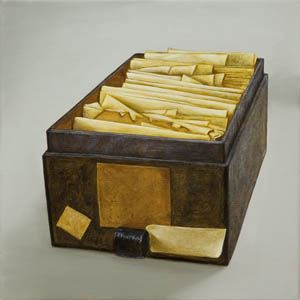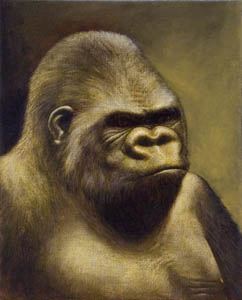RIGO SCHMIDT
If one considers museums representative containers of history, they preserve and display a continuous, expanding repertoire of culture and scholarship: stuffed, preserved, petrified, behind glass, or on canvas, selections of the development of man and his surroundings are presented, seeming legible like a picture book.
But what becomes legible here is less a history of culture or science itself, but the history of its representation, linked to the relationship of a civilization to its objects of display. From here, Rigo Schmidt looks back to two lines of development that affect his own perception as a painter: the evolution of humanity as part of surrounding nature, and humanity’s attempts to distinguish himself from his surroundings by way of culture and science. The antiquated atmosphere of natural history museums shimmers through his images as well as the constructed nature of a scientific worldview that has produced this form of museum representation. Small, finely worked formats at first seem to continue this fascination for isolated object studies—they even seem to adopt this pose. But behind this lies the observation of observation, and thus the study of civilized surroundings as an already mediated image. For Rigo Schmidt often finds his subjects where nature and reality were already once filtered: in photographs, paintings, or showcases they were “cropped” in their natural context and brought to a standstill. The staged objectivity of pig, mouse, or skull is repeated in painting, where it regains a new vividness, a shift of media and the return of “deceptively real” pictures from museums and laboratories to an artificial format. Rigo Schmidt intuitively points to the continuing problem of representation: that it remains—more or less—suggestive trick. From the perspective of the painter, the handmade artificiality of his chosen “storage medium” painting far more convincingly matches the quality of a certain staging, defined as reality. These media world images that humanity creates in subjective observation, secure inner archival spaces. Only when they are projected onto the canvas does it become clear that they have no shadows. But this realization of loss allows us to regain a new faith in painting. To that extent, the painting’s depictive reflex is only apparently realistic. The even, somewhat too garish green of a landscape or the foggy brown layer covering over some other paintings instead indicate the lacking authenticity of the subjects. Painting proves here the more adequate medium of reality depiction, because it shows how humanity by domesticating nature to a decorative object, reproducible photography, or a commercially available houseplant, attempts to get a picture, and presents this vision as his own representation. At the foundation of these small format works, usually showing “irrational” nature is the question of what exactly establishes the superior and clever perceptive of humanity gifted with rationality. This doubt exposes the intention to perceive nature as an origin, condition, and the continually mutating, manipulating surroundings of life.
The question of the justification of hierarchies and priorities is echoed in Rigo Schmidt’s way of working. The undirected synchronicity of his observations is best illustrated in a diorama box. The museum showcase as an old fashioned model of objectifying reality perception displays his subjective spectrum of interests in various drawings fanned out in a collage-like way. The showcases, obviously from another context, also make this thematic-exhibition into a quotation. A similar procedure can be found in the use of painterly possibilities. The linear narrative with its formal achievements is conceived as a non-hierarchical reservoir of technical means: elements from drawing like white heightening are mixed with the glazing application of watercolors and the strength of oil painting, to create a kind of “impressionist realism,” that dissolves as one approaches the painting into loose brushstrokes. Rigo Schmidt does not work conceptually, but he uses the artificiality of his painting consciously as a strength of the medium, It gains its tension from the shifting gaze between the presented object and deception as the result of depiction—his own and the mediated perception of his surroundings. It seems as if the painter intended to weaken the imaginative power of his paintings with a misty glaze that somewhat removes the represented from the beholder’s approach. Despite the classical seeming artistry of his work, it is this strategy of disturbance that again and again restores an aesthetic distance to the beholders, like the glass of a museum showcase. (Bettina Reichmuth)
Available works
De jonge Duitse kunstenaar Rigo Schmidt (°1974) pakt op deze tentoonstelling uit met een reeks schilderijen op klein formaat, met daarop in een strakke kadrage prototypische objecten, die meestal opduiken in de klassieke natuurhistorische musea. De achterliggende idee van deze technisch meesterlijk en quasi hyperrealistisch geborstelde werkjes, is dubbel. Enerzijds reflecteert de kunstenaar hiermee sterk op de ambigue bewaar- en verzamelfunctiefunctie die een museum bekleedt binnen een hedendaagse cultuur die gedomineerd wordt door snelheid, vluchtigheid, internationalisering en mediatisering. Anderzijds is het net deze (overdaad aan) cultuur waarmee de mens haar opponent, de natuur, probeert te domineren en zelfs te overstelpen. Veel van de geschilderde objecten in Schmidts schilderijen zijn immers opgezette dieren, mensapen of poppen van prehistorisch leven die uit hun natuurlijke biotoop of geschiedenis werden gerukt, en in rasechte ‘ecce homo’-stijl geisoleerd te kijk worden gezet voor het onderzoekende oog van de al dan niet rationeel-wetenschappelijk geïnteresseerde toeschouwer. Het fijne aan het werk van Rigo Schmidt is dat hij deze dubbele problematiek intuïtief gekozen lijkt te hebben in functie van zijn medium.
De bijna neurotische menselijke drang om de (grillige) natuur te isoleren en (wetenschappelijk) te observeren, vertoont immers een niet te onderschatten overeenkomst met de schilderkunst zelf. Ook schilderkunst draait in hoofdzaak rond de problematiek van isolatie, presentatie en observatie van onderwerpen. De schilder kiest, kadreert en interpreteert zijn inspiratiebronnen, en zet deze door middel van verf – letterlijk – naar zijn hand. Maar schilderkunst heeft nog een extra troef in dit verband. Door haar expliciete materiële omzetting van een beeld in verf, krijgt de schilder de kans om het probleem rond observatie en isolatie zélf te observeren. Het probleem wordt dus getoond, en niet langer louter beleefd. Schmidts werk is een schilderkunstige kijkoefening in menselijke kijkdrang. Een kijkdrang te kijk gezet door geverfde kijkafstand… (Thibaut Verhoeven, Mei 2006)
Biography
° Altenburg, 1974
1993
A-Level exams
1993–1994
Civil service, Leipzig
1996–2004
Student at Hochschule für Grafik und Buchkunst, Leipzig
1998–2004
Student in painting under Professor Arno Rink at Hochschule für Grafik und Buchkunst, LeipzigLives and works in Leipzig
Einzelausstellungen
2006
Galerie Transit, Mechelen
Wohnmaschine, Berlin
2005
Rigo Schmidt, Gavin Tremlett, Dimitris Tzamouranis, Wohnmaschine, Berlin
Galerie Brigitte March, Stuttgart
2004
Plaza Suite, Union, London
2004
Laden für Nichts, Leipzig
1999
Laden für Nichts, Leipzig
Gruppenausstellungen
2006
Galeria Leme, Sao Paulo, Brasilien
Kunsthalle der Hypo-Kulturstiftung, München
Zweidimensionale, Leipzig
2005
Union Gallery, London, UK
Wohnmaschine, Berlin
Galerie Brigitte March, Stuttgart
Galerie Kampel, München
2004
Union Gallery London, UK


